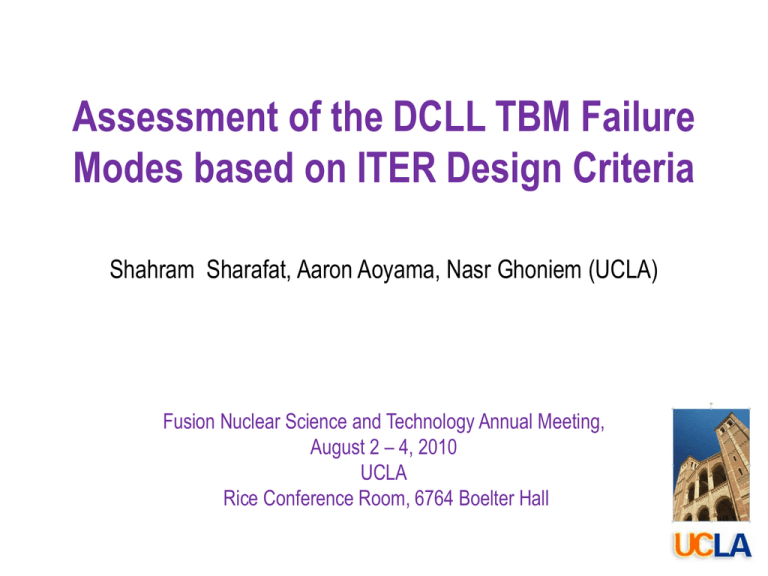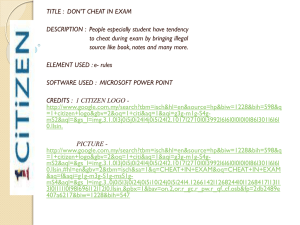
Assessment of the DCLL TBM Failure
Modes based on ITER Design Criteria
Shahram Sharafat, Aaron Aoyama, Nasr Ghoniem (UCLA)
Fusion Nuclear Science and Technology Annual Meeting,
August 2 – 4, 2010
UCLA
Rice Conference Room, 6764 Boelter Hall
INTRODUCTION
The DCLL TBM is a safety-critical structure, which operates under low- and heavy
loading conditions (normal- and off-normal).
Under normal operating conditions plastic deformation (shake down) will occur, the
TBM structure will undergo loss of ductility ( 3̴ .7 dpa EOL), … many potential failure
modes exist.
Stress analysis alone cannot predict failures* by buckling, global and/or local
collapse, incremental collapse (ratcheting), creep-fatigue, etc.
*see backup slides
Failure Mechanisms
LOW TEMPERATURE:
I.
II.
Limit load collapse, under a single load application.
Excessive displacement and/or deformation, limiting functionality, under a single load application, below the
limit load.
III. Structural instability or buckling, under a single load application.
IV. Progressive collapse by ratcheting under cyclic load.
V. Fracture by the initiation and/or propagation of a crack under a single load application.
VI. Fatigue failure under cyclic loading.
VII. Breach of the pressure boundary, or structural collapse caused by corrosion induced loss of section.
HIGH TEMPERATURE:
VIII. Excessive deformation - loss of functionality, due to creep deformation under essentially steady load.
IX. Creep buckling - time dependent structural instability leading to catastrophic collapse or loss of function.
X. Cyclically enhanced creep deformation (Creep Ratcheting) - Accelerated creep deformation caused by
repeated resetting of stresses by cyclic plastic strain, due to cyclic loads superimposed on a sustained load
history.
XI. Accelerated creep rupture - Accelerated creep damage caused by repeated resetting of stresses by cyclic
plastic strain, due to cyclic loads superimposed on a sustained load history.
XII. Creep/fatigue interaction - Failure under cyclic conditions in a period, usually less than fatigue due to the
cyclic condition alone, or creep rupture due to time-at-stress alone, the mechanism for which may include
other time/temperature related phenomena, such as oxide layer cracking, and may be material specific.
ALL TEMPERATURES:
XIII. Corrosion, oxidation, and mass transport phenomena
XIV. Irradiation induced failure mechanisms
INTRODUCTION
The DCLL TBM is a safety-critical structure, which operates under low- and heavy
loading conditions (normal- and off-normal).
Under normal operating conditions plastic deformation (shake down) will occur,
furthermore the TBM structure will undergo loss of ductility ( 3̴ .7 dpa EOL)…
Stress analysis alone cannot predict failures* by buckling, global and/or local
collapse, incremental collapse (ratcheting), creep-fatigue, etc.
Fortunately, general purpose FEM codes can be used to evaluate performance of
loaded structures in compliance with “Design Criteria” rules.
Design Criteria rules offer tools for assessing the performance of loaded structures by
means of limit and shakedown analysis methods of “Design By Analysis” (DBA).
Ultimately, design of robust and reliable TBM structures requires sensitivity studies
that:
— combine DBA analyses with probabilistic methods, and
— perform large-scale FEM analyses with the inclusion of hardening and damage.
*see backup slides
TALK OUTLINE
Structural Evaluation Plan (SEP) – Flow of Design Analysis
Definition of SDC-IC Design Criteria
F82H material property data for SDC-IC
Large-scale FEM analysis of the DCLL TBM
Selecting paths (total of 13) through critical locations of the
DCLL TBM structure
Application of low- and high temperature SDC-IC rules to the 13
paths.
Tabulated Factor-of-Safety (FoS) of all 13 paths for both unirradiated and irradiated operating conditions.
STRUCTURAL EVALUATION PLAN (SEP)
Structural Evaluation Plan (SEP)
Basic Design Configuration: Sufficient analysis to establish basic shapes and sizes for
interfacing with other components.
Deformation Limits & Functional Requirements: Identify deformation limits and
functional requirements established by the manufacturer for proper performance.
Structural Evaluation:
o
Failure Modes: Identify location of dominant failure modes and load conditions
(pressure, thermal, seismic, etc.).
o
Screening Analysis:
Make a preliminary evaluation of the adequacy of the design.
•
Typical screening analysis consist of an initial linear elastic analysis,
comparison with design limits adjusted to account for significant
fabrication and environmental effects.
o
Detailed Inelastic Analysis: After Screening Analysis is complete.
o
Support Test Program for Component Design Analysis: Manufacturer should
identify structural tests required in support of design analysis.
Sample Screening Analysis
Design Specifications
Initial Design
Design Iteration
Elastic Analysis
NO
Design
Criteria Met
YES
Report to Owner
NO
Design Iterations
Simplified Inelastic Anal.
NO
Design
Criteria Met
YES
Report to Owner
NO
Proposal for Detailed
Inelastic Analysis
Proposal for Supporting
Test Program
Screening Analysis Reported Here
Design Specifications
Initial Design
Design Iteration
Flow Chart
Elastic Analysis
NO
Design
Criteria Met
(next slide)
YES
Report to Owner
NO
Design Iterations
Simplified Inelastic Anal.
NO
Design
Criteria Met
YES
Report to Owner
NO
Proposal for Detailed
Inelastic Analysis
Proposal for Supporting
Test Program
Redes
optional
Analysis Flow Chart for Low-Temperature
SDC-IC Design Rules for Given Operating Conditions
Elastic analysis
Elasto-plastic analysis
no
Select design margins
Tables IRB 3220.1
and IRB 3220.2
Define Operating
Conditions
Redesign
optional
Elastic analysis
Elasto-plastic analysis
no
Satisfy
Satisfy strain limit ?
IRB 3211.2
no
no
Satisfy
no
PL P b Q F
or
no
Satisfy K
no
no
Satisfy J I Limit ?
IRB 3213.2
no
I
Limits ?
IRB 3213.1.1
and
IRB 3213.1.2
• PM+Pb/K = creep damage limit
• PL = yesImm. Plastic collapse andyes
or
plastic instabiliy
Satisfy 3S m or
Satisfy
elasto-plastic
Bree
diag. limit ?
no
• PL+QL = Plastic Flow Localization
ratcheting limits ?
IRB 3311.1 or
IRB
IRB 3311.2
•3312PL + PB + Q + F = ductility
yes
yes
exhaustion
limit
Satisfy elasto-plastic
fatigue limit ?
no
Satisfy elastic
fatigue limit?
Satisfy elasto-plastic
ratcheting limits ?
IRB 3312
no
Satisfy 3S m or
Bree diag. limit ?
IRB 3311.1 or
IRB 3311.2
yes
Satisfy elasto-plastic
fatigue limit ?
IRB 3323.2
no
yes
no
Limits ?
yes
yes
yes
I
IRB 3213.1.1
and
IRB 3213.1.2
yes
no
no
no
Satisfy J I Limit ?
IRB 3213.2
or
Limit ?
IRB 3212.1
yes
yes
Satisfy K
Q L Limits ?
L
IRB 3211.1
no
Q L Limits ?
L
IRB 3211.1
P L , and
Satisfy
Satisfy strain limit ?
IRB 3212.2
P L , and
P
or
Pm P b /K ,
P
Pm P b /K ,
• Brittle Fracture:
KI = stress intensity factor
yes
(a =h/4),
Satisfy
no
Satisfy strain limit ?
PL P b Q F
• 3Sm ratcheting due
to
IRB 3212.2
Limit ?
yes cyclic loading limit
IRB 3212.1
yes
no
no
Satisfy strain limit ?
IRB 3211.2
Satisfy elastic
fatigue limit?
IRB 3323.1
yes
Satisfied Buckling limit ?
IRB 3400
yes
Satisfied deformation limit
for functional adequacy ?
IRB 3040
no
yes
Design
requirementsmet for
givenoperating
conditions
Procedure for using SDC-IC Design Criteria
Identify Failure Mechanisms
and Loading Conditions
Perform Elastic Thermomechanical FEM
Identify Paths through TBM
Structure
Linearize Stresses along
Paths
Apply Low- and High
Temperature Design Rules
Check Factor of Safety
SDC-IC DESIGN CRITERIA
Some Terminology
PRIMARY AND SECONDARY STRESS:
o “Primary” stress denotes that part of the total stress in equilibrium
with external mechanical forces (pressure).
o “Secondary” stress consists of all contributions to an internal, self
equilibrating or residual stress state (thermal stress).
• Primary stress is instrumental in causing gross structural collapse
whereas the secondary stress is of concern for cyclic load or local
damage accumulation.
HIGH TEMPERATURE:
o “High temperature” refers to the operating range of temperature
within which time dependent, thermally activated deformation and
damage processes occur.
o “High temperature” is, for the most part synonymous with
“in the creep range”, but others, such as thermal ageing and
oxidation/ corrosion are also important.
Schematic Diagram of ASME Design Stress Determination
High Temperature
Regime
Low Temperature
Regime
Loading Category Criteria Level
Loading Category
Operational Loading
Category Condition
(Damage Limits)
Normal, Upset
SDC-IC Criteria
Level
A
Likely Loading
Emergency
C
Unlikely Loading
Faulted
D
• Level A and C loadings include electromagnetic loading during plasma disruptions.
• Level D postulates earthquakes.
Level A Design Criteria prevent against:
• immediate plastic collapse,
• immediate plastic instability,
• Immediate plastic flow localization,
• fast fracture,
• local fracture due to exhaustion of ductility,
• ratcheting,
• fatigue,
• thermal creep,
• buckling
Criteria
Definition of Design SDC-ICDesign
Criteria
LOW TEMPERATURE DESIGN RULES:
Necking and Plastic Instability Limit - Primary membrane
stress (Immediate plastic collapse and plastic instability)
Necking and Plastic Instability Limit Primary membrane and bending stress
Local primary membrane stress –
(Immediate plastic collapse and plastic instability)
Local primary membrane stress –
(Immediate plastic collapse and plastic instability)
Plastic Flow Localization Limit - Primary plus secondary
membrane stress (Immediate plastic flow localization)
Ductility Exhaustion Limit (Local fracture, exhaustion of ductility)
Ductility Exhaustion Limit – Without peak stress
(Local fracture, exhaustion of ductility)
HIGH TEMPERATURE DESIGN RULES:
Creep Damage Limit
Ratcheting Limit - Progressive deformation or
ratcheting
Ratcheting Limit - Progressive deformation or
ratcheting
Ratcheting Limit - Progressive deformation or
ratcheting:
TEST No. A.2
Sm (T m , t m )
Pm
PL Pb
PL min
K eff S m (T m , t m )
1.5 S m (T m , t m ), S y, mi n ( Tm , t m )
PL 1.1 Sm (Tm , t m )
PL Q L Se (T m , t m )
PL Pb Q F Sd (T , t , r2 )
PL Pb Q S d ( T, t , r3 )
SDC-IC Design Criteria Procedure
Identify Failure Mechanisms
and Loading Conditions
Perform Elastic Thermomechanical FEM
Identify Paths through TBM
Structure
Linearize Stresses along
Paths
Apply Low- and High
Temperature Design Rules
Check Factor of Safety
LARGE-SCALE FEM ANALYSIS OF
DCLL TBM
Thermo-mechanical Modeling of TBM
Solid Modeling of 2009 – 2010 TBM :
Used Original CATIA TBM Model
Created solid bodies for He & PbLi volumes
Total of 91 solid bodies were assembled into the
TBM Solid Model before importing it into ANSYS
for meshing and analysis (including Flexible Joints)
Thermo-mechanical Loads:
Gravity (account for PbLi weight)
Uniform FW surface heat flux (q” = 0.5 MW/m2)
He-pressure: 8 MPa; PbLi pressure: 2 MPa
Convective cooling (location dependent)
Volumetric heating (material & location dependent)
He-Solid Body
(assembled)
Exploded View of He-Solid Bodies
(temperature coded)
Thermal Analysis: Temperatures
Tmax=560 oC
Tmax = 560 oC at top of FW
~550 oC
~507 oC
~495 oC
FW
radial
poloidal
BW
toroidal
radial
Structural Analysis: Stress
Based on ITER
FW Flexible Joint
Von Mises stress contours
S
i
d
e
Top View
(TBM Lid)
Flexible Joint Detail
V
e
i
w
APPLYING LOW- AND HIGH
TEMPERATURE SDC-IC RULES TO DCLL
SDC-IC Design Criteria Procedure
Identify Failure Mechanisms
and Loading Conditions
Perform Elastic Thermomechanical FEM
Identify Paths through TBM
Structure
Linearize Stresses along
Paths
Apply Low- and High
Temperature Design Rules
Check Factor of Safety
CHOOSING PATHS ALONG CRITICAL LOCATIONS:
(1) Highest Stress
(2) Midsection of FW
(3) Coldest Structure
Path through highest stress location
0.4 m
0.6 m
0.2 m
1.6 m
Cross Section Cut through the TBM (mid-plane)
Zooming in on Region
with Highest Stress
Cross Section Cut through the TBM Mid-plane
TBM Lid
(top of TBM)
Region with
Highest Stress
FW (Plasma side)
Paths near highest stress location
Path through the FW along
the Midsection of the TBM
Path through the Mid-section of the TBM FW
Zooming in on the TBM
Midsection - FW
Paths through the TBM FW
Choosing a Path through TBM Structure
with Lowest Temperature
Path through the Coldest Structure
Zooming in on the TBM
Coldest Structure: He-Inlet
Path through the Coldest Structure of the TBM
He-Inlet Duct
to TBM
Paths through the Coldest Structure
350 oC
SDC-IC Design Criteria Procedure
Identify Failure Mechanisms
and Loading Conditions
Perform Elastic Thermomechanical FEM
Identify Paths through TBM
Structure – Material Data
Linearize Stresses along
Paths
Apply Low- and High
Temperature Design Rules
Check Factor of Safety
F82H MATERIAL PROPERTY DATA:
(Temperature and irradiation damage dependent)
Sy(av)=558.76−0.81574θ+2.7621×10−3θ2−3.476×10−6θ3
Sy(min)=0.9025(558.76−0.81574θ+2.7621×10−3θ2−3.476×10−6θ3)
Su(av)=666.44−0.84514θ+2.1019×10−3θ2−2.617×10−6θ3
Su(min)=0.9384(666.44−0.84514θ+2.1019×10−3θ2−2.617×10−6θ3)
Sy(irr)=Sy(av,unirr)(1+0.56628φ+0.44327φ1.0673)
Su(irr)=Su(av,unirr)(1+0.56628φ+0.44327φ1.0673)
Sm=0.3128(666.44−0.84514θ+2.1019×10−3θ2−2.617×10−6θ3)
q is temperature in oC
Example: Average Yield Stress (SY(av))
Sy(av)=558.76−0.81574θ+2.7621×10−3θ2−3.476×10−6θ3
Sy(irr)=Sy(av,unirr)(1+0.56628φ+0.44327φ1.0673)
F82H - ̶ Sy(av) (irradiated correlation based on HFIR)
1000
900
800
3.7 dpa (ITER-TBM EOL)
700
Stress (Mpa)
2 dpa
600
1 dpa
500
un-irr.
400
300
200
100
0
-200
0
200
400
Temperature (oC)
600
800
PATH AVERAGED TEMPERATURES
AND STRESSES
SDC-IC Design Criteria Procedure
Identify Failure Mechanisms
and Loading Conditions
Perform Elastic Thermomechanical FEM
Identify Paths through TBM
Structure – Material Data
Linearize Stresses along
Paths
Apply Low- and High
Temperature Design Rules
Check Factor of Safety
LINEARIZING STRESS ALONG
THE PATHS.
Image Set 1: Linearization Example
Total
Stress
ij
Linear stress
( ij ) l
Supporting
line segment
o
Non-linear stress
( ij ) b
Bending stress
( ij ) m
Membrane stress
x3
x
hc
( ij ) nl
3
ht
Stress along path near top of TBM
Membrane plus Bending plus Non-linear
TBM Design Criteria Stress Results
Path Average Temperatures
In order to properly determine the material properties to compare our stress results to, temperature data
was collected along each of the 13 paths. Average temperatures along each path were determined, and
using the correlations, material property data was calculated accordingly.
Average
Temperature
Sy(av)
Sy(min)
Su(av)
Su(min)
Sy(irr)
Su(irr)
Se (=Sm)
Sd
[C]
[MPa]
[MPa]
[MPa]
[MPa]
[MPa]
[MPa]
[MPa]
[MPa]
1
452.62
433.08
390.86
458.36
430.12
582.07
616.05
205.35
410.70
2
456.62
431.24
389.20
455.77
427.70
579.60
612.57
204.19
408.38
3
461.60
428.87
387.05
452.48
424.61
576.41
608.15
202.72
405.43
4
522.25
390.96
352.84
404.87
379.93
525.47
544.16
181.39
362.77
5
447.42
435.38
392.93
461.65
433.21
585.16
620.47
206.82
413.64
6
430.63
442.10
399.00
471.66
442.61
594.20
633.93
211.31
422.62
7
439.40
438.72
395.94
466.54
437.80
589.65
627.04
209.01
418.03
8
413.18
448.06
404.38
481.20
451.56
602.21
646.75
215.58
431.17
9
413.22
448.05
404.37
481.19
451.55
602.20
646.73
215.58
431.15
10
451.50
433.59
391.31
459.08
430.80
582.75
617.01
205.67
411.34
11
392.14
454.01
409.74
491.65
461.36
610.20
660.79
220.26
440.53
12
391.30
454.22
409.93
492.04
461.73
610.49
661.32
220.44
440.88
13
374.45
458.09
413.43
499.63
468.86
615.69
671.52
223.84
447.68
Path
Se: allowable total stress intensity; Sd: allowable total membrane plus bending stress intensity
APPLYING SDC-IC DESIGN CRITERIA
SDC-IC Design Criteria Procedure
Identify Failure Mechanisms
and Loading Conditions
Perform Elastic Thermomechanical FEM
Identify Paths through TBM
Structure – Material Data
Linearize Stresses along
Paths
Apply Low- and High
Temperature Design Rules
Check Factor of Safety
TBM Design Criteria Stress Results
Design Criteria
Irradiated Material
Properties
Unirradiated Material
Properties
Minimum
Factor of Safety
Path
Minimum
Factor of Safety
Path
3.97
7
2.77
7
4.34
7
3.03
7
1.5 S m (Tm , t m ), S y, mi n ( Tm , t m )
5.95
7
4.16
7
PL 1.1 Sm (Tm , t m )
4.37
7
3.05
7
PL Q L Se (T m , t m )
1.02
1
0.71
1
PL Pb Q F Sd (T , t , r2 )
1.86
4
1.3
4
PL Pb Q S d ( T, t , r3 )
1.9
4
1.33
4
4.46
8
3.12
8
3.57
10
3.57
10
33.12
7
14.94
7
8.99
1
5.87
1
2.1
1
1.41
1
Pm
PL Pb
PL min
Sm (T m , t m )
K eff S m (T m , t m )
Criteria
Definition of Design SDC-ICDesign
Criteria
LOW TEMPERATURE DESIGN RULES:
Necking and Plastic Instability Limit - Primary membrane
stress (Immediate plastic collapse and plastic instability)
Necking and Plastic Instability Limit Primary membrane and bending stress
Local primary membrane stress –
(Immediate plastic collapse and plastic instability)
Local primary membrane stress –
(Immediate plastic collapse and plastic instability)
Plastic Flow Localization Limit - Primary plus secondary
membrane stress (Immediate plastic flow localization)
Ductility Exhaustion Limit (Local fracture, exhaustion of ductility)
Ductility Exhaustion Limit – Without peak stress
(Local fracture, exhaustion of ductility)
HIGH TEMPERATURE DESIGN RULES:
Creep Damage Limit
Ratcheting Limit - Progressive deformation or
ratcheting
Ratcheting Limit - Progressive deformation or
ratcheting
Ratcheting Limit - Progressive deformation or
ratcheting:
TEST No. A.2
Sm (T m , t m )
Pm
PL Pb
PL min
K eff S m (T m , t m )
1.5 S m (T m , t m ), S y, mi n ( Tm , t m )
PL 1.1 Sm (Tm , t m )
PL Q L Se (T m , t m )
PL Pb Q F Sd (T , t , r2 )
PL Pb Q S d ( T, t , r3 )
Design Criteria
Irradiated Material
Properties
Unirradiated Material
Properties
Minimum
Factor of Safety
Path
Minimum
Factor of Safety
Path
3.97
7
2.77
7
4.34
7
3.03
7
1.5 S m (Tm , t m ), S y, mi n ( Tm , t m )
5.95
7
4.16
7
PL 1.1 Sm (Tm , t m )
4.37
7
3.05
7
PL Q L Se (T m , t m )
1.02
1
0.71
1
PL Pb Q F Sd (T , t , r2 )
1.86
4
1.3
4
PL Pb Q S d ( T, t , r3 )
1.9
4
1.33
4
4.46
8
3.12
8
3.57
10
3.57
10
33.12
7
14.94
7
8.99
1
5.87
1
2.1
1
1.41
1
Pm
PL Pb
PL min
Sm (T m , t m )
K eff S m (T m , t m )
SUMMARY
SDC-IC Design Rules were reviewed and F82H material properties were
collected and extrapolated for SDC-IC (including KIC)
Large-scale FEM analysis of the DCLL TBM stress results were broken down
into membrane, bending, and total stress along 13 different paths through
the TBM structure.
Low- and high temperature SDC-IC rules were applied to the paths.
Normal operating loading based Factor-of-Safety (FoS) for both un-irradiated
and irradiated materials show that :
o
DCLL structural design satisfies all SDC-IC design criteria for normal
operation for irradiated (3.7 dpa) material properties
o
The FoS for “Plastic Flow Localization Limit” is less then 1 for at the FW
near the top of the TBM (Path 1).
o
An inelastic analysis would have to be performed to demonstrate that
stress relaxation due to local deformation reduces the membrane plus
bending stress along Path 1 to acceptable levels.
BACKUP SLIDES
Brittle Fracture Limit Design Rules
Path
1
2
3
4
5
6
7
8
9
10
11
12
13
a
0.25
0.50
0.75
1.00
1.25
1.50
1.75
2.00
2.25
2.50
2.75
3.00
3.25
PL+QL
Stress
KI
PL+Pb+Q+F
Stress
KI
65.52
29.46
62.15
26.40
10.14
4.31
120.01
17.60
10.69
4.81
0.00
8.48
1.24
119.98
17.51
8.47
1.24
4.90
5.36
65.53
50.21
17.07
6.88
0.75
0.82
3.78
2.90
0.98
1.09
3.05
3.48
65.57
50.21
17.07
6.85
0.47
0.53
3.78
2.90
0.98
1.08
Brittle Fracture Limit FoS
Path
1
2
3
4
5
6
7
8
9
10
11
12
13
Maximum KI
10.69
4.81
8.48
1.24
0.75
0.82
3.78
2.90
0.98
1.09
KIC
213.38
215.06
216.66
220.90
210.56
194.68
204.41
167.50
167.56
212.84
138.16
137.34
126.45
FoS
20.12
45.08
24.84
156.59
223.89
204.96
56.28
47.71
139.50
116.43
Ultimate Stress
1000
F82H -̶ Su(av) (irradiated data is based on Sy-like corellation
900
800
3.7 dpa (ITER TBM EOL)
Stress (MPa)
700
2 dpa
600
1 dpa
500
un-irr.
400
300
200
100
0
-200
0
200
400
Temperature (oC)
600
800
Membrane Stress
F82H -̶ Sm (irradiated data: S_y like correlation (HFIR data))
400
350
Stress (MPa)
300
3.7 dpa (ITER TBM EOL)
Series3
250
Series2
200
un-irr.
150
100
50
0
-200
0
200
400
Temperature (oC)
600
S_m = 1/3 S_u(min,T,dpa)
800
Creep Rupture Stress
350
F82H -̶ Creep Rupture Stress, Sr (10,000 hr; un-irr.)
300
Stress (MPa)
250
avg.
200
min.
150
100
50
0
0
200
400
600
Temperature (oC)
800
Membrane Rupture Stress
F82H -̶ Smt (10,000 hr; irradiated based on HFIR S_y data)
400
350
Stress (MPa)
300
S_m (3.7 dpa)
S_m (un-irr.)
250
S_t
200
150
100
50
0
-200
0
200
400
Temperature (oC)
600
800
Uniform Elongation
F82H-mod Uniform Elongation (un-irr.)
6
Data (Klueh
2002)
Elongation (%)
5
4
3
2
1
0
0
200
400
600
o
Test Temperature ( C)
Allowable total stress intensity:
800
Allowable primary plus secondary
membrane stress intensity:
SDC-IC Low Temperature Design Criteria
LOW TEMPERATURE:
I.
Limit Load – A minimum requirement of a component to support a single application of the worst
combination of all the static loads: ensuring that the collapse load exceeds the maximum service load by a
suitable factor.
II.
Limiting excessive deformation – Limit placed on displacement and/or deformation, even when the
deformations are “small”, i.e. insufficient to affect structural integrity; limit may be defined in the Code as a
fixed % of a characteristic dimension (note that displacement may be elastic, while deformation is caused by
inelasticity).
III.
Buckling –Load induced geometric imperfections that may lead to premature local or gross structural collapse
(bows, bulges, or wrinkles).
IV.
Ratcheting – Incremental collapse under a cyclic sequence of loads needs to be avoided. Avoidance of
ratcheting can be assured by demonstrating shakedown to a stable cyclic elastic state using a conservative
approximate method.
V.
Fast Fracture – Failure by cracking rather than gross plastic deformation (depends on local conditions rather
than gross structural behavior and is often catastrophic). First line of defense is based on measures of fracture
resistance. - A “postulated crack” is used in some post construction evaluations such as that provided
VI.
Fatigue – Crack initiation and propagation, which is a function of local stress/strain state rather than gross
structural behavior. Evaluation of fatigue life uses either stress/life or strain/life data as the design criterion.
VII. Corrosion – Corrosion alone is invariably considered as a material selection process preceding design.
SDC-IC High Temperature Design Criteria
HIGH TEMPERATURE:
Elevated temperature operation introduces thermally activated, time dependent processes.
Creep is the foremost of these, causing both time dependent deformation and changes to the
material.
VIII. Creep rupture – Creep rupture failure is the time dependent equivalent of limit load collapse at low
temperature where material strength is replaced by the creep strength of a standard specimen for
some specified finite life, such as the 2/3rds stress for rupture in 100,000 hours adopted by Sections I
and VIII of the ASME Code.
IX.
Creep ratcheting (cyclically enhanced creep deformation) – Demonstration that reversed plastic
straining due to cyclic loads does not lead to an accelerated general creep deformation rate at a
structural level.
X.
Accelerated creep rupture - Demonstration that accelerated creep damage due to periodic resetting
of stresses due to cyclic plasticity, does not exceed Code design criteria for cumulative damage.
XI.
Creep/Fatigue interaction – Demonstration that material damage due to the combined effects of
cyclic loading and sustained hold periods at elevated temperature do not exceed allowable limits.
XII. Corrosion, oxidation, and mass transport phenomena – demonstrations of how these effects take into
account effective section size, and possible material interaction or degradation.
SDC-IC All Temperature Design Criteria
ALL TEMPERATURES:
XV. Radiation effects – demonstration and incorporation of material degradation or changes,
including possibly drastic changes in applicability of failure criteria, e.g. ductile vs. brittle
failure criteria. Some examples of radiation effects include but are not limited to:
• Irradiation induced swelling
• Irradiation induced creep
• Plastic Flow localization due to irradiation (dislocation tunneling)
• Ductility exhaustion due to irradiation exposure
• Irradiation induced effects on fatigue, and on K_IC
XVI. Seismic loads – demonstration and assurance that such severe and infrequent loading, or
more frequent depending upon location, does not pose as a safety risk to the public, and
criteria to define permissible operation after such an event, or not.
Images depicting linearization of stresses on
an example path - TOP of the TBM FW
Path – Through the FW at the Top of TBM
Total Stress
Membrane Stress
Membrane plus Bending Stress
Cross Section Cut through the TBM Mid-plane
Top of TBM
Mid-Plane
Max Stress Concentration
inside TBM (330 Mpa)
FW (Plasma)
Cross Section Cut through the TBM Mid-plane
PbLi Channel
He
Top of TBM
Max. Temperature
534 oC
FW (Plasma side)
Cross Section Cut through the TBM Mid-plane
Back of TBM
He-Inlet Duct
350 oC
Top of TBM
FW (Plasma side)
DEFINITION OF “HIGH TEMPERATURE”
“High temperature” is taken to refer here to the operating range of
temperature within which time dependent, thermally activated
deformation and damage processes, even under nominally steady loads
below yield, become a significant factor in the behavior of load bearing
components.
“Elevated temperature” is, for the most part synonymous with “in the
creep range”, but others, such as thermal ageing and oxidation/corrosion
are also important.
The threshold temperature is not unique. It is strictly a function of the
mode of failure being considered, as well as the design lifetime. For
instance, the threshold temperature for constant loading conditions, where
stresses are expected to relax to a relatively low steady state, will be higher
than one based on cyclic conditions which cause stresses to be repeatedly
reset to the yield stress by cyclic plastic deformation.
The implication is that NH assumes failure by creep to occur on a section when
the extreme fiber reaches a critical damage equivalent to a tensile test at the
maximum steady state stress. This assumption means that local stress relaxation
from high local stresses (“F” stresses) is being ignored in the process of evaluating
creep life.
The common wisdom is that “rupture” is the result of void initiation and growth,
which is observed at the macroscopic level as “tertiary” creep.
Tertiary creep, since it is presumed to be a sign of void formation, is perceived to
be a “bad thing”. On the contrary, tertiary creep, whether caused by voids or any
other mechanism, is a desirable phenomenon from the point of view of a
redundant structure, because it allows the stress at the highest stressed location
to relax, so reducing the damage rate locally, and prolonging the life of the
component, sometimes by orders of magnitude.
Most pressure vessel applications have hovered around, or
slightly below the “cliff top” (figure next slide), where
temperature dependencies are significant but contained in a
range of 10 to 50% or so of some nominal value.
The much higher temperatures envisioned for the future push
the application point down to the foot of the “cliff”, where even
moderate temperature differences can represent very large
property variations, which may be higher than current
approximate methods can cope with.
CLASS-1 Nuclear Components Guidelines
RDT F 9-5T:
Guidelines and Procedures for Design
of Nuclear System Components at
Elevated Temperature, September 1974 (pp 271)
Westinghouse Electric Corporation,
Advanced Reactor Division
Madison, Pennsylvania, 15663
NE
F 9-5T:
Guidelines and Procedures for Design
of Class 1 Elevated Temperature
Nuclear System Components, October 1986 (pp 361)
Report: DE93 011215
Oak Ridge National Laboratory
Oak Ridge, TN
Stress analysis alone cannot predict failures*
o A major feature of all mechanical design Codes is a
recognition that “stress” is not a sufficient basis
for a failure criterion.
o Depending on the nature of the failure mechanism
involved, the appropriate criterion may be only
part of the total stress, or a function of the multiaxial stress state.
o Methods of stress classification are therefore an
element which is present in all reputable Codes.







